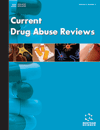- Home
- A-Z Publications
- Current Drug Abuse Reviews
- Issue Home
Current Drug Abuse Reviews - Current Issue
Volume 10, Issue 1, 2017
-
-
Cannabis: An Overview of its Adverse Acute and Chronic Effects and its Implications
More LessAuthors: Talitha C. Ford, Amie C. Hayley, Luke A. Downey and Andrew C. ParrottIn many communities, cannabis is perceived as a low-risk drug, leading to political lobbying to decriminalise its use. Acute and chronic cannabis use has been shown to be harmful to several aspects of psychological and physical health, such as mood states, psychiatric outcomes, neurocognition, driving and general health. Furthermore, cannabis is highly addictive, and the adverse effects of withdrawal can lead to regular use. The Read More
-
-
-
Long-term Administration of Antipsychotic Drugs in Schizophrenia and Influence of Substance and Drug Abuse on the Disease Outcome
More LessAuthors: Felix-Martin Werner and Rafael CovenasBackground: Many schizophrenic patients with a long-term administration of antipsychotic drugs do not regularly adhere to the prescribed pharmacotherapy. Antipsychotic drugs constitute a palliative, but not a curative treatment, and the long-term effect of these drugs is not secure. Patients tend to consume nicotine and alcohol, as well as some patients consume drugs such as cannabis and amphetamines. Objective: Read More
-
-
-
Drug-Drug Interactions in Cocaine-Users and their Clinical Implications
More LessBackground: Drug-Drug Interactions (DDIs) represent a common problem in clinical practice during drug treatments. DDIs can both induce the development of adverse drug reactions or reduce the clinical efficacy of each drug. Objectives: The main objective of this review was to analyze the pharmacokinetic and pharmacodynamic DDIs in cocaine consumers, focusing the interest on their clinical implications. Methods: The Pu Read More
-
-
-
Role of Repetitive Transcranial Magnetic Stimulation (rTMS) in Treatment of Addiction and Related Disorders: A Systematic Review
More LessAuthors: Ramkrishna Makani, Basant Pradhan, Umang Shah and Tapan ParikhBackground: Addiction and related disorders are devastating with their tremendous social, psychological, and physical consequences for which development of optimally effective treatments is long overdue. Repetitive Transcranial Magnetic Stimulation (rTMS) is relatively safe and is becoming an emerging therapeutic tool for these conditions. Methods: This systematic review was conducted using PubMed, PsycINFO, Read More
-
-
-
Thiamine and Alcohol for Brain Pathology: Super-imposing or Different Causative Factors for Brain Damage?
More LessAuthors: Rita Moretti, Paola Caruso, Matteo Dal Ben, Silvia Gazzin and Claudio TiribelliBackground: Drinking more than the recommended limits is a worldwide emerging problem, difficult to circumscribe, and alcohol-related brain damages are an under-recognized health problem. Alcohol-cognitive disruption can be considered as transient and recoverable if the alcohol consumption is limited and occasional; if not, it can progress to the so-called Alcohol-Related Dementia (ARD), or to the Wernicke encep Read More
-
-
-
The Need to Move from Describing to Evaluating the Effectiveness of Indigenous Drug and Alcohol Residential Rehabilitation Services: A Systematic Review
More LessAuthors: Doug James, Anthony Shakeshaft, Alice Munro and Ryan J. CourtneyBackground and Objectives: Despite the importance of Indigenous drug and alcohol residential rehabilitation, the knowledge supporting these services is limited. This paper aims to: (i) identify the research output related to Indigenous drug and alcohol residential rehabilitation services; (ii) classify identified studies according to their methodology; and (iii) describe key characteristics of clients and services, and critique the re Read More
-
-
-
Proceeding of the 9th Alcohol Hangover Research Group Meeting
More LessBackground: Alcohol hangover is a common occurrence among individuals who have experienced an episode of heavy alcohol consumption the previous night. Until now defined as the general feeling of misery that develops once the Blood Alcohol Concentration approaches zero. Despite its prevalence and several related adverse consequences, insufficient research has been conducted with regards to this matter and further Read More
-
-
-
High Prevalence of Abandoned Needlesticks from Injecting Drug Users in Milton Keynes, UK: Analysing Access to Needle Exchange Centres and Drug Dependency Services
More LessAuthors: Dushyant Mital, Steve Conway and Joanne TruemanBackground: In 2015, Milton Keynes (MK) Council waste management team shows an increase in the numbers of abandoned used needles being found across MK. MK is an area of high Human Immunodeficiency Virus (HIV) prevalence and high Hepatitis C (HCV) in People Who Inject Drugs (PWID), the overriding concern was for the safety of the public. Methods: Analysis of data collection to understand the scale and spread Read More
-
Most Read This Month Most Read RSS feed
Article
content/journals/cdar
Journal
10
5
false
en


